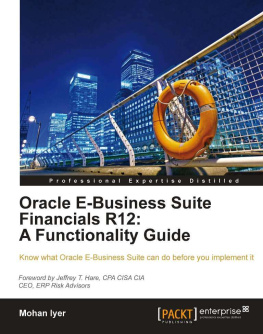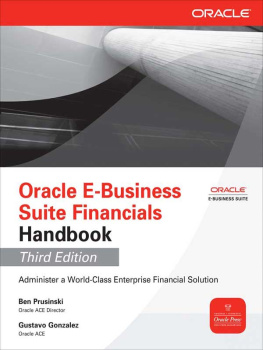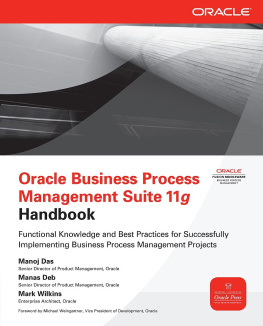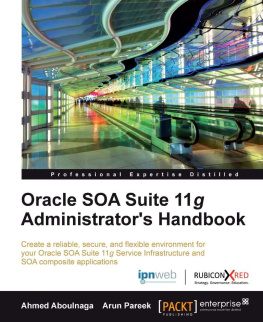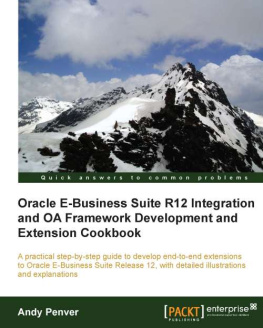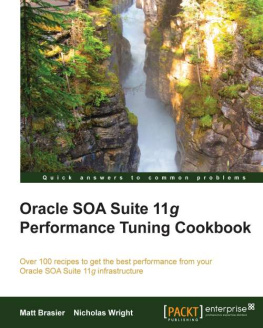I have known Mohan Iyer for many years, first professionally and now personally. Mohan is a tireless advocate for the development of best practices and for making the Oracle E-Business Suite world a better place. He is one of those guys who digs into issues and understands it both technically and functionally before making a recommendation to a client. Mohan is also a great asset to the user community through Oracle Applications Users Group (OAUG), NorCal Users Group, and other forums.
This book is the culmination of many, many years of Mohans experience and research. Readers of this book will be blessed with great insight and comprehensive analysis of the functionality and best practices related to Oracles R12 E-Business Suite release. I am pleased to be able to recommend this book.
This book focuses primarily on issues related to functionality. If you have questions on internal controls or security relating to this content, feel free to e-mail me at <>.
About the Author
Mohan Iyer has more than 20 years' experience in system implementations with the last 15 years implementing Oracle Financials. He has a strong background in Finance and Accounting, having had these as his major subjects in college. He has an Accounting degree from the University of Bombay (Mumbai), India.
His skill set includes a full range of financial applications in Oracle Applications and related modules where there is a financial impact. His broad range of skills have helped him with his implementation of, Record to Report, Procure to Pay, and Quote to Cash processes, with reengineering and crystallizing processes during implementations. His tenure as a Consultant and a Manager of financial applications in corporate America, brings to the table a wide range of experience with financial processes that include inter-company, multi-currency, statutory needs, and process flows to manage operational changes that will lead to efficiency and appropriate accounting results. He has been a board member of the NorCal OAUG and Multi-National SIG. He is the coordinator of the GL SIG and has presented various papers at OAUG and related conferences.
He lives in California with his wife and two kids. He can be contacted at <> or on 408 859 4484.
Visit www.fscpsolutions.com for a peek at training material (the training material can be found under the "Training Collateral" link) and other content that he has presented at various conferences and public meetings. The presentation collateral can be found under the link "Presentation Collateral".
He has worked on multiple projects where training has been a key deliverable and has developed multiple formats of delivering effective training.
FSCP Solutions Inc. also has generic training material and is building content that will help the finance user get an easy path to effectively use the E-Business Suite. The training collateral on the website is generic training material.
Acknowledgement
I have to acknowledge the support and patience from my wife and her continued support in allowing me the time to research and write this book. It would not have been possible to make this effort a success without her support. I would also like to extend an acknowledgement to people who are my peers and helped me immensely in reviewing the book and giving me valuable feedback regarding content and writing style. My heartfelt gratitude and thanks go to Alex Fiteni, Ajay Pradhan, Brian R. Bouchard, Faun deHenry, John Peters, Ketan J Thanki, Scott Gordon, and Thomas Simkiss.
I would also like to thank the many others that I have reached out to ask specific questions related to content in some of the chapters where their expertise was far higher than mine.
Last of all and once again, I would like to thank my family, my wife and two kids who bore the brunt of the long hours when I researched and wrote the book.
About the Reviewers
Brian R. Bouchard is a passionate person who enjoys helping others understand the complexities around Oracle Financials applications. He was introduced to Oracle Applications back in the 90s when he served as the Fixed Assets Manager at Motorola. Playing an integral role in the implementation and rollout of the application, he decided to change career paths from Accountant to Consultant. In his consulting career, he has designed, developed, and implemented over 50 full life cycles of Oracle EBS Applications ranging from Release 9 Release 12.1.3. He has always strived to help others and to find the most efficient ways to perform tasks and to utilize the system. This characteristic led him to develop bolt-on products for Oracle Assets and he opened the doors of his own company in 2006. As President and CEO of Chi-Star Technology SM, he is striving to improve the utilization of Oracle Assets and to streamline manual efforts by automating some of the most tedious processes in Oracle Assets. Due to his passion to educate people on the complexities of Oracle Applications, he has also conducted well over 200 training sessions on various applications and releases. In the summer of 2009, he founded the CST Education Network, which was started to offer low cost education on Oracle Applications via webinars and video training.
He realized the areas of opportunity in Oracle Assets: Asset Transfers and Reconciliation. In April 2006, the introduction of AssetCross came to the market as a solution to the manual asset transfer procedure. The AssetCross software will transfer single or multiple assets between corporate depreciation books, transfer full or partial (cost or units) assets, translate transferred amounts to the receiving depreciation books currency, and maintain an audit trail with the original asset. In June 2008, the introduction of AssetTie came to the market as a solution to the reconciling Oracle Assets procedure. The AssetTie software will capture balances from Oracle General Leger and compare them to balances in Oracle Assets and identify variances. The same technology is used to compare the transactions copied from Corporate Books to the Associated Tax Books. Within seconds of posting a journal entry from Oracle Assets, the user can determine if there are any reconciling differences.

